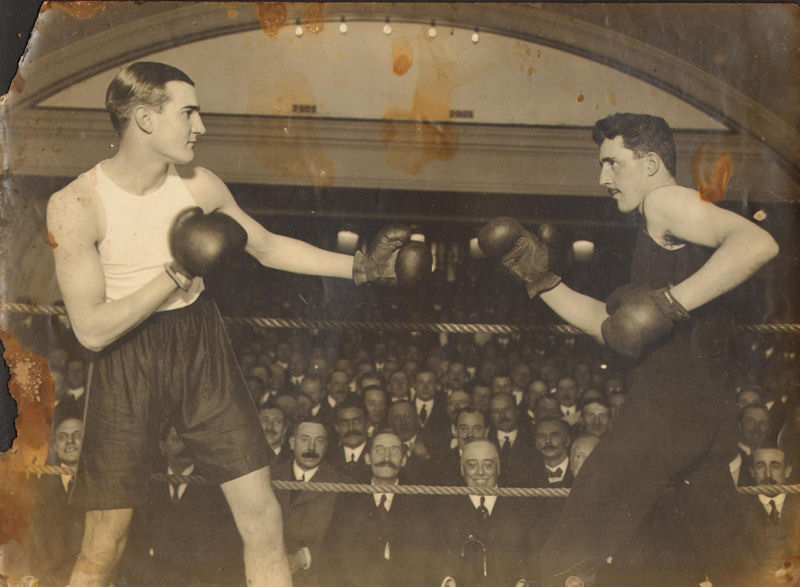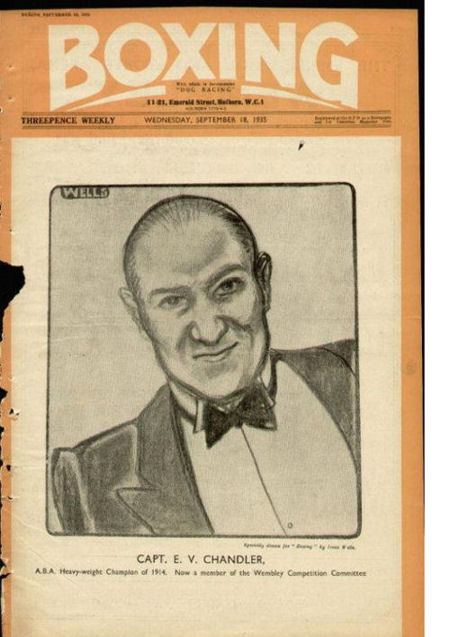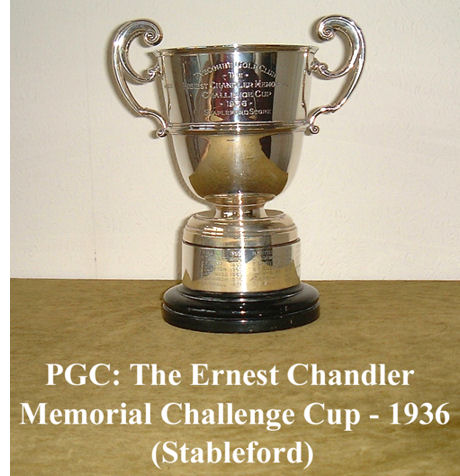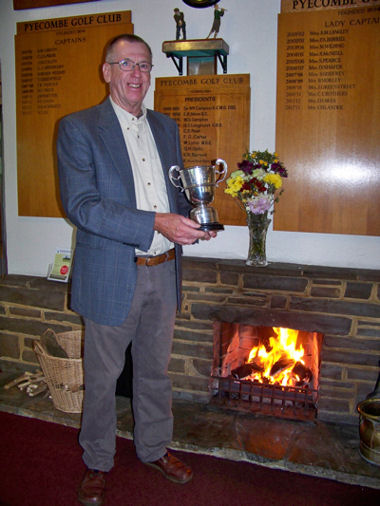| Return to Chandler Memories index page |

Share your Chandler memories –
Send your old photos of long ago Chandler family groups, reunions or locations to the Web-Editor at  . See the Chandler Gatherings page for more up-to-date photos.
. See the Chandler Gatherings page for more up-to-date photos.
Return to Chandler Memories, page 8:
Chandler Family of England and South Africa
(Genetic Chandler Family #71)
Ernest Vivian Chandler, World Amateur Heavyweight Boxing Champion
In the photo above, Ernest Vivian Chandler (in white top and black shorts) is boxing in a charity exhibition match. The following is handwritten on the back of the photograph:
The photo above and others on this page were provided by Errol Chandler, Ernest Vivian Chandler’s first cousin twice removed. Errol says that ‘S.E.B.C.’ refers to Stock Exchange Boxing Club. This was a charity exhibition match with Oxford University. Private Pat Mc Enroy of the Irish Guards represented the Army & Navy. The photo was made by J. Woodland Fullwood, Norwood, London. The match probably took place around 1913.
 E.V. Chandler, the middle-weight amateur boxing champion, who is also an expert cyclist. He has won many races on the track, and tried his hand in other sports, such as running, swimming, skating, etc., with much success.
Ernest and Jeffery Farnol
At left in the photo is Hughson Hawley, American father-in-law of Jeffery Farnol. Mr Hawley was a well-known English-born artist who got his start painting scenery in theatres. In New York he found fame as an artist and architectural renderer and only returned to England in the latter part of his life. Jeffery Farnol and his American wife lived in the U.S. for a while and, in addition to writing, Jeffery sometimes also supported himself as a scenery painter in New York theatres, and Farnol and his wife were at times supported by his father-in-law, Mr. Hawley. After Hawley lost all his money in the stock market crash in 1929, he and his wife and another daughter moved to England, where they were in turn financially supported by the now wealthy and famous Farnol. The in-laws lived at Sunnyside, the Farnol home in Brighton, until both Mr. & Mrs. Hawley died. Ernest Chandler was disliked and mistrusted by some members of Jeffery’s family, including his second wife, but Ernest’s niece, Mrs. Shirley Bishop of Chardonne, Switzerland, ably defended both Ernest and Jeffery in a letter to Farnol’s biographer. More about Hughson Hawley’s life and career: More about Jeffery Farnol: Tragic death Ernest died of blood poisoning in August 1936, in Brighton, England, at about age 35. An article in the New York Times titled “Inquest on Captain E. V. Chandler – Death After Giving A Blood Transfusion” reports the verdict of the inquest was “death by misadventure.” Ernest had given a blood transfusion to his friend Sir Harry Preston a fortnight (2 weeks) before his death and some believed the small wound from the transfusion had become infected. Dr. L. R. Janes, pathologist, said death was due to acute septicemia, and all the medical professionals quoted in the article seemed very anxious that the death not be blamed on the process of donating blood. The article mentioned that Captain Chandler died without having been told of Sir Harry’s death. (New York Times, August 22, 1936, Issue 47460, col F, courtesy of Errol Chandler) The Angus, Scotland, Evening Telegraph reported on August 20, 1936, that Samuel B. Chandler of London, age 52, had died suddenly in London only three days after the death of his brother Ernest. Samuel had traveled to Brighton to visit his dying brother, returning to London after Ernest’s death. Sir Harry Preston was the owner of several hotels in Brighton, including the Albion opposite the pier, frequented by many of the leading stage and sporting stars of the time. He was a sports promoter, especially boxing, and known for his work with charitable causes. One of his most famous associates was Edward, Prince of Wales (later Edward VIII and ultimately the Duke of Windsor). More about Sir Harry Preston: “Chandler Cup” played yearly at Pyecombe Golf Club in Sussex Errol discovered that the Pyecombe Golf Club at Pyecombe, Sussex See an explanation of the Stableford Scoring System, invented in 1931 by Dr. Frank Stableford: How the Stableford Scoring System works We know that Ernest died of blood poisoning days after giving blood for a transfusion to his friend Sir Harry Preston. The small incision made by the doctor for the transfusion was accidentally opened again while Ernest was playing golf. Blood poisoning set in and he died within days.
Norbury Bowling Club Trophy – a second life for another silver cup
Errol later learned of a second cup won in 1914 by Ernest Vivian Chandler that became a trophy in another sport. Ernest won the title “Heavyweight Boxing Champion of Great Britain” and was presented with a solid silver trophy (see photo at left). In 1944, eight years after Ernest’s death, his brother Wilfred James Chandler gave the cup to the Norbury Bowling Club, London, to be played for annually until the bowling club closed in 1966. This “second life” for the cup was inscribed on the cup. It was then returned to Wilfred. After he died in 1986 the cup was sold and disappeared for over 30 years until it was found again in April 2015, 101 years after Ernest first won it. The photographs were taken on May 2, 2015. The cup is solid silver, properly hallmarked and made by Mappin & Webb. It weighs 48 ounces. Above: Ernest’s 1914 Heavyweight Boxing Champion of Great Britain cup. Below: Engraving detail from the 1914 cup.
Photos and information provided by CFA member Errol Chandler of Draycott, Somerset, England. Errol is Ernest’s 1st cousin, twice removed. They are members of Chandler DNA Group 71. Errol Chandler
|
||||||||||||||||||






 Ernest arrived in New York with a group of boxers on the White Line ship
Ernest arrived in New York with a group of boxers on the White Line ship 
 Ernest V. Chandler is in the center of the photograph at left. At right is Jeffery Farnol, a prolific British author of ‘swashbuckling’ novels. The men were friends, and at one time Ernest was Farnol’s agent and secretary. One of Farnol’s many books, Gifford of Weare, published in 1928, was dedicated to Ernest V. Chandler. The dedication referred to Ernest as “My Trusty Friend.”
Ernest V. Chandler is in the center of the photograph at left. At right is Jeffery Farnol, a prolific British author of ‘swashbuckling’ novels. The men were friends, and at one time Ernest was Farnol’s agent and secretary. One of Farnol’s many books, Gifford of Weare, published in 1928, was dedicated to Ernest V. Chandler. The dedication referred to Ernest as “My Trusty Friend.”




